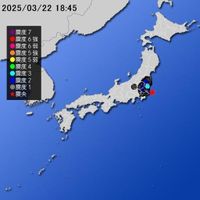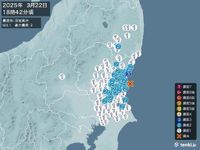On March 22, 2025, Japan experienced a series of earthquakes, the most significant of which occurred off the coast of Ibaraki Prefecture. Around 6:42 PM local time, a magnitude 4.1 earthquake was recorded, with its epicenter located 50 km below sea level. This tremor was felt across various parts of Ibaraki, with a maximum seismic intensity of 3 reported in Hitachi City.
The Japan Meteorological Agency specified the details of the quake, highlighting that there was no tsunami risk associated with this event. Residents were urged to remain aware of aftershocks, even though the primary shock itself had subsided without causing major damage or panic.
Earlier in the day, at 3:05 AM, a minor magnitude 1 earthquake rattled Satsumasendai City in Kagoshima Prefecture. This tremor was slightly more pronounced in Gero City, Gifu Prefecture, recorded at 1:04 AM. Both were mild and raised little concern among residents.
Seismic data released by the agency also covered recent earthquakes prior to the March 22 incident. On March 20, two minor earthquakes were noted, the first occurring at 04:28 AM and another shortly after at 04:27 AM. Similarly, events from March 19 drew attention, with two additional earthquakes reported at 1:29 PM and 1:26 PM, respectively. These quakes were cataloged to inform the public of seismic activity in their regions.
On March 18, the most significant tremors of the week occurred, with a magnitude 4 earthquake hitting Kumamoto Prefecture, registering a seismic intensity of 4. The earthquake was reported at 8:07 AM, causing concern but ultimately resulting in no reported injuries. In conjunction, Unzen City in Nagasaki Prefecture and Yatsushiro City in Kumamoto Prefecture logged seismic intensities of 2 at 6:37 PM that same day.
The Japan Meteorological Agency continues to monitor seismic activities closely and is committed to providing timely updates to ensure public safety. Earthquake preparedness remains critical, especially in a geologically active region like Japan, where earthquakes, while frequent, can vary dramatically in intensity.
Since these occurrences, the emphasis on constructing buildings resistant to seismic activity, disaster drills, and community readiness is paramount to mitigate the effects of future earthquakes. Acknowledging that preparedness is crucial can reassure residents and help them contribute to safety in their communities.
In light of the recent seismic activity, several local governments have initiated community awareness campaigns and drills aimed at preparing citizens for potential major quakes. These proactive measures are essential, given Japan's lengthy history of devastating earthquakes, including the catastrophic events of 2011 that reshaped the country’s disaster response protocols.
Overall, March has proven to be a relatively active month in terms of seismic activities following the patterns of previous years where late winter to early spring months typically experience heightened seismic activity in Japan. The interconnection between tectonic plates beneath the archipelago continuously leaves the country on alert.
As we move into the spring months, the requirement for public vigilance about earthquakes remains. The Japanese government encourages citizens to familiarize themselves with proper emergency responses and to stay updated on the information disseminated by local meteorological offices. Residents are advised to check on their earthquake emergency kits and be ready to act should another seismic event occur.
In conclusion, while the recent earthquakes posed no immediate danger, they serve as a reminder of the natural forces at play in the country. Preparedness and awareness continue to be key elements for safety as Japan navigates its relationship with the unpredictability of earthquakes. Understanding seismic warnings and being equipped to respond effectively are crucial for all residents.






